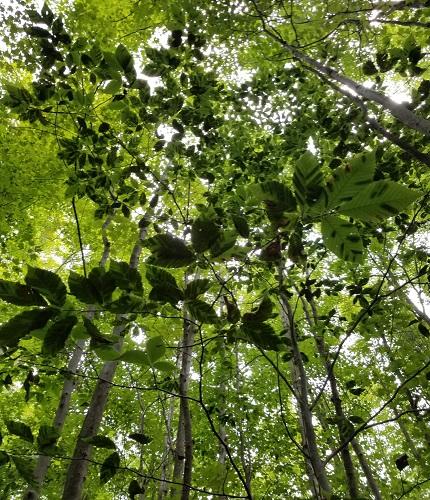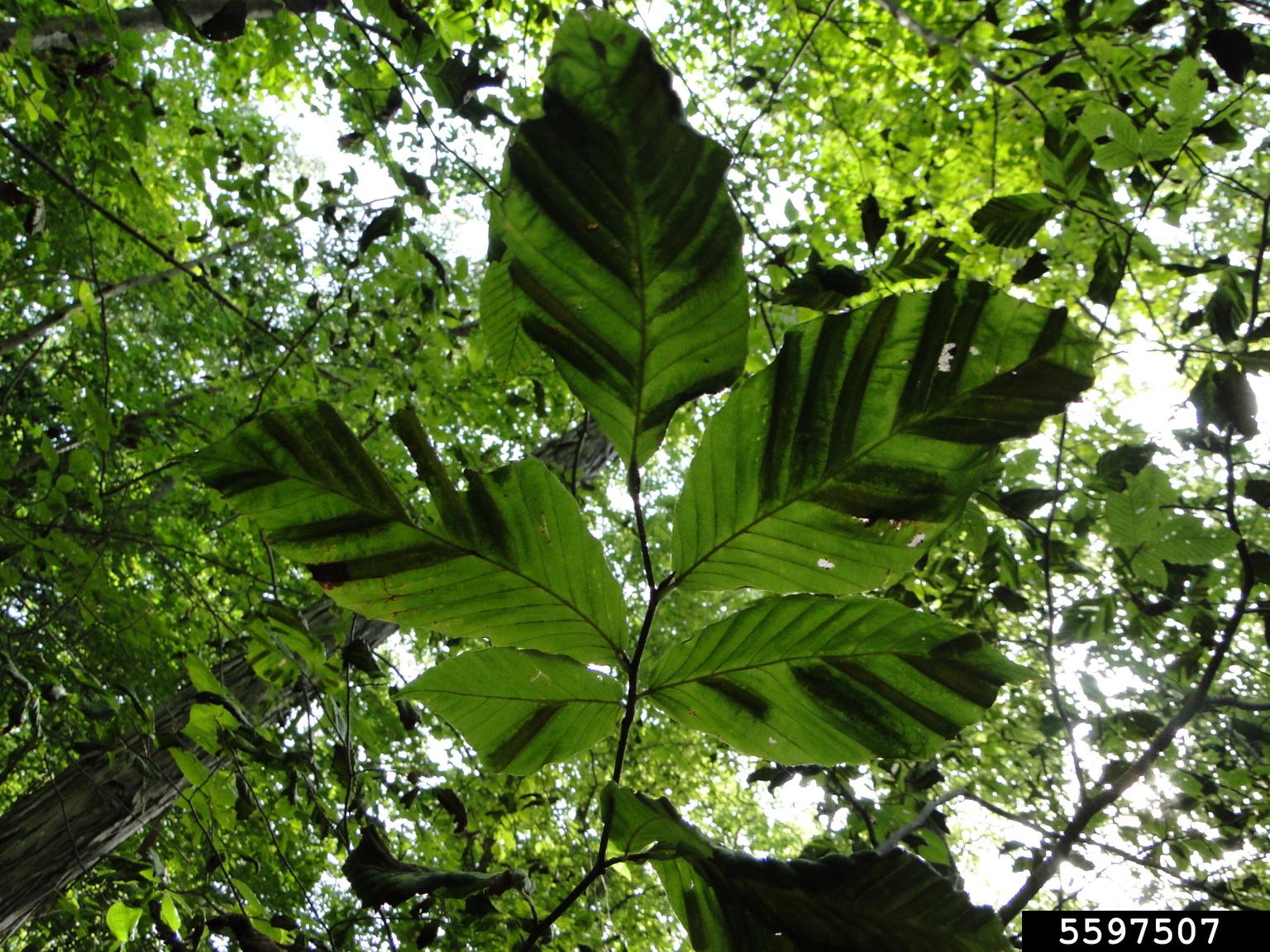A novel non-native microbe is locally impacting beech tree health and mortality throughout the northeastern United States and southern Canada. The microbe, Litylenchus crenatae mccannii, a subspecies of a nematode found in Japan, is causing beech leaf disease (BLD). BLD is a foliar disease affecting leaves of beech trees. BLD was first documented in 2012 after it was discovered affecting leaves of American Beech (Fagus grandifolia) trees in Lake County in northeastern Ohio. Since then, it has spread to nine states throughout the northeast, the mid-Atlantic, and the Canadian province of Ontario. Our native beech as well as non-native varieties, such as European beech that is commonly used in landscaping and in gardens, are susceptible to BLD. The Maryland Department of Agriculture’s Forest Pest Management section has been actively surveying forests statewide for the disease since 2019. The disease has not yet been documented in Maryland. However, it has been found in neighboring Pennsylvania counties of western Maryland and one county in northern Virginia adjacent to southern Maryland.
The nematodes increase in numbers as they infect leaves throughout the growing season. How the leaves are impacted is still under investigation. Similar nematodes of the family Anguinidae affect other tree species by producing galls in their leaves. While researchers at Penn State University and others have observed galls in affected beech tree leaves, they are still studying the galls’ function as it relates to BLD. The disease affects the structure of the leaves, interfering with their normal biological functions. Affected leaves exhibit a unique banding, or darkening, of the leaf area between the veins. Symptoms progress from leaf banding to shrinkage in leaf size, as well as heavy banding and a crinkling leather texturing of the leaf. Advanced symptoms include leaf curling and dead and dying leaf tissue. As the damage progresses over the years, leaf buds are aborted and premature leaf drop occurs. Trees will typically die in two to seven years after infection. BLD can affect all sizes of beech trees in the forest, but younger trees in the understory are more susceptible.

The characteristic banding is best seen from underneath looking up into the canopy of the trees. If surveying saplings closer to the ground, turn over the leaf to view its underside. The banding that BLD exhibits is quite distinct. There are, however, some other lookalike issues in the forest affecting beech trees that may result in false identification. Anthracnose, caused by fungi, is relatively common among beech trees and can cause brown spots and dead tissue in leaves. Sometimes, anthracnose also causes leaves to curl. However, the damage anthracnose causes is not restricted to the area between veins. Another disease, erineum patch, also causes patchy leaf damage on beech trees. Unlike BLD and anthracnose, erineum patch is caused by mites that do not threaten the health of the tree. The mites’ damage does not show the distinct banding of BLD. Finally, a native insect known as the beech leaf rolling aphid can also cause curling and fading/yellowing between leaf veins. Beech leaf rolling aphids are also native and do not threaten tree health.
BLD nematodes overwinter in the buds of the next season’s leaves and continue to affect them as they develop. There is currently no known treatment to address BLD although researchers continue to seek mitigation strategies. While it is unknown how the nematodes spread to affect new trees, landowners and managers of properties with beech trees can take certain precautions. Avoid coming in contact with areas of infected vegetation to help prevent spread to unaffected trees. Avoid spreading leaves, twigs, soil, branches, seedlings, and similar material from infected areas. As a further precaution, disinfect footwear with a solution of bleach and water immediately after walking through stands of infected trees. Please report any suspected findings of beech leaf disease to MD’s Department of Agriculture’s Forest Pest unit by email at fpm.mda@maryland.gov, or call 410-841-5870.
Resources:
“Beech Leaf Disease.” Forest Health, Insects & Diseases. Ohio Department of Natural Resources.
“Beech Leaf Disease.” New York State Department of Environmental Conservation.
“Beech Leaf Disease.” Pest Alert, USDA U. S. Forest Service. March, 2022.
Reed, SE, Greifenhagen, S, Yu, Q, et al. Foliar nematode, Litylenchus crenatae ssp. mccannii, population dynamics in leaves and buds of beech leaf disease-affected trees in Canada and the US. Forest Pathology. 2020; 50:e12599. https://doi.org/10.1111/efp.12599
Branching Out, Vol. 31, no. 2 (Spring 2023)
Branching Out is the free, quarterly newsletter of the Woodland Stewardship Education program. For more than 30 years, Branching Out has kept Maryland woodland owners and managers informed about ways to develop and enhance their natural areas, how to identify and control invasive plants and insects, and about news and regional online and in-person events.
